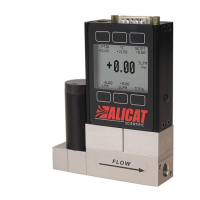28
Navigating and Customizing Your Flow Controller
Adjusting the PID controller (continued)
Tuning the PD
2
I control algorithm
Alicat's PD
2
I control algorithm (also called PDDI) is used in dual-valve ow and
pressure controllers to provide faster response and reduce oscillations. This
algorithm uses typical PI terms and adds a squared derivative term (D):
• The larger the P gain, the more aggressively the controller will correct errors
between the commanded setpoint and the measured process value.
• The larger the I gain, the faster the controller will correct for osets based
on the size of the errors and the amount of time they have occurred.
• The larger the D gain, the faster the controller will predict needed future
corrections based on the current rate of change in the system. This often
results in slowing the system down to minimize overshoot and oscillations.
Troubleshooting valve performance with PID tuning
The following issues can often be resolved by adjusting the PID gain values
for your mass ow controller.
• Fast oscillation around the setpoint
» PD: Reduce the P gain in decrements of 10%.
» PD
2
I: Reduce the P gain in decrements of 10%, and then reduce the I gain
to ne-tune.
• Overshot setpoint
» PD: Reduce the P gain in decrements of 10%.
» PD
2
I: If D is not 0, increase the P gain in decrements of 10%.
• Delayed or unattained setpoint
» PD: Increase the P gain in increments of 10%, and then decrease the D
gain by small amounts to ne-tune.
» PD
2
I: Increase the P gain in increments of 10%, and then increase the I
gain to ne-tune.
Note: Alicat congures PD
2
I algorithm gains for dual-valve controllers
based on expected process conditions. If you are switching a PDF
controller to PD
2
I for the rst time, try gain settings of P=200, I=200
and D=20 as a starting point.
Valve tuning can be complex. Please give us a call, and we'll be happy
to guide you through the process. Or, visit alicat.com/pid for more
detailed instructions.

